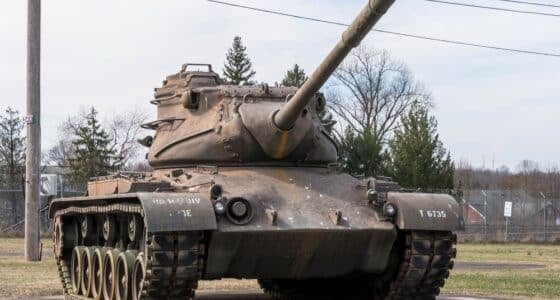Fort Knox is a U.S. Army base located in the state of Kentucky. Covering 109,000 acres, it covers parts of three different Kentucky counties. For more than a century, it has variously served as a training center, an Airfield, home to several Cavalry regiments and armored divisions, and today serves as home to the Army Human Resources Command Center and trains 10,000 ROTC cadets each summer. It is considered one of the most multifunctional installations in the U.S. Army.[1]
The soldiers who trained at Fort Knox through the years did so with the knowledge that their service represented a risk, but they thought that peril would come at the hands of America’s enemies. Whether they faced combat or not, Army veterans who served at Fort Knox were exposed to danger in the form of asbestos, the carcinogenic mineral that the military used extensively for construction, infrastructure, equipment, and other applications between the 1930s and 1980.
While the dangers of asbestos were unknown to the military and the troops, many of the companies that provided asbestos-containing materials were aware that it had been linked to significant health problems. In recent years, many of those companies have been forced to provide compensation to the veterans and civilian employees who were exposed to asbestos and subsequently diagnosed with malignant mesothelioma, asbestosis, asbestos-related lung cancer, and other illnesses.

The History of Fort Knox
Fort Knox has been a part of American history as far back as the Civil War, when fortifications built on the site were contested by both the Union and Confederate armies. During World War I, much of the area surrounding what would become Fort Knox was used for field artillery training, and in 2018, the War Department established a Field Artillery Brigade Firing Center Cantonment to accommodate 45,000 men on 20,000 acres of land that it leased. Expansion and construction of the base began shortly after, including barracks, warehouses, and mobilization buildings that followed the same plans and used the same standardized materials that were ordered for military installations around the country. The site was named Camp Knox in honor of General Henry Knox, the Continental Army’s Chief of Artillery during the Revolutionary War and the nation’s first Secretary of War.[1]
After the Armistice, troops from the surrounding areas were transferred to the Camp, and many of those returning from overseas were discharged from service there. The site continued to be used for tactical training, and by 1922 was the second largest Army training center in the country, but it was closed shortly thereafter when the artillery officers’ basic school was moved to Oklahoma. Camp Knox still was used as an active training center for the 5th Corps area for the army and was briefly designated as Camp Henry Knox National Forest until the War Department created the Mechanized Force in 1930 and chose Camp Knox for its headquarters. In 1932, the site became a permanent installation again and was redesignated as Fort Knox. Anti-Aircraft Artillery and Air Corps exercises were held there, and the site was used to test an air defense warning system and to compare new bombers against older ones.[1]
More housing and support facilities were required to accommodate the influx of personnel, and in 1937 the 1st Cavalry Mechanized Regiment was asked to guard the gold that the Treasury Department was moving into its new depository, adjacent to the base. Fort Knox also served as an induction center for the Civilian Conservation Corps, and the base housed groups that were trained to improve forests, build roads, and more. Additional infrastructure was built, with much of the work done through the Works Progress Administration.[1]
As World War II started in Europe, the Army turned to Fort Knox in its preparations. The Armored Force was created and headquartered there, training thousands of citizen soldiers in the use of the tank. Even more construction was required to manage the influx of personnel, who were taught armor tactics, tank gunnery, communications, and maintenance. Fort Knox was also chosen as a testing location for the Navy’s Landing Ship Tank well deck. Naval architects constructed a mockup of the well deck to track airflow and ventilation systems to see if they effectively removed poisonous gases from vehicles parked there.[1]
After World War II, Fort Knox was used as a Prisoner of War camp and continued being used for training. The 3rd Armored Division trained more than 300,000 soldiers during its time at Fort Knox. The site is also the home of the Patton Museum, which opened in 1949 to showcase armored vehicles and other items associated with the famed general. When the Korean War began, the site was reinvigorated as a training site for armored units.[1]
By the mid-1960s, more than one million trainees had completed training programs at Fort Knox, and the base continued its training role through the Vietnam War and the end of the Cold War. Fort Knox supported Operation Desert Shield, sending replacement troops and materials to commanders in the theater of operations, and when Operation Desert Storm began in 1991, the M1 Abrams and M2/M3 Bradley tanks and their soldiers were mobilized from there. In 1992, the Army Recruiting Command Headquarters was moved there, and after 9/11 the base provided training and operational support for Operation Enduring Freedom. When Operation Iraqi Freedom began in 2003, Fort Knox trained soldiers and tested the Stryker Interim Armored Vehicle that was used there and in support of Operations Noble Eagle, Enduring Freedom and Iraqi Freedom, as well as the Global War on Terror.[1]
Today, Fort Knox is the site of the Human Resources Command and continues its role in readiness training. All ROTC Cade Summer Training is completed there, with approximately 10,000 cadets training there each summer.
How Was Asbestos Used at Fort Knox?
Because Fort Knox went through so many transitions and accommodated so many hundreds of thousands of soldiers as they trained for combat, construction on the base was going on constantly. From its earliest days, when the base used standardized military plans for barracks and administrative buildings, to the end of the Cold War, asbestos was a material that the military counted on as a key component for the construction of buildings, infrastructure, and the insulation of equipment and vehicles. It was cheap, easily accessible, and added both strength and protection against heat and flame.
Though asbestos was used in the construction of almost every military base, Fort Knox had one notable additional reason for the presence of the carcinogenic material: Tanks. Because the base was the home of the Armored division, tanks and their parts were always a part of the environment. The massive vehicles, as well as the warehouses where their parts were inventoried and the repair areas where the vehicles were maintained, were a constant source of asbestos exposure, as the mineral was used in tanks’ brake pads, clutch plates, gaskets, and insulation.
Asbestos-containing materials and parts used at Fort Knox included:
- Adhesives
- Automobile, truck, and tank brakes, clutch plates, gaskets, and insulation
- Caulking
- Ceiling tiles
- Cement foundations
- Drywall
- Electrical wiring
- Epoxies
- Fireproofing materials
- Floor tiles
- Gaskets
- HVAC systems
- Insulation materials
- Paint
- Pipes
- Plumbing
- Roofing
- Sealants
- Siding
- Soundproofing
- Valves
- Vinyl floor tiles
- Wallboard
Who Was at Risk of Asbestos Exposure at Fort Knox?
In addition to being a training site, Fort Knox was constantly a construction work zone. The soldiers who lived and ate in Army buildings were exposed to asbestos simply by inhaling fibers that may have been airborne as a result of construction or damage, and workers on the base were also at risk as they carried out their duties. When soldiers came to Fort Knox, many of them were either trained in new occupations or used their existing trade skills to contribute to the installation’s operations. With asbestos used in so many areas of Fort Knox, many of these soldiers, as well as civilian workers, were at risk for exposure to the carcinogenic material.
Those who were most endangered at Fort Knox included:
- Electricians
- Contractors
- Construction Workers
- Roofers
- Plumbers
- Carpenters
- Boiler Workers
- Pipefitters
- Machinists
- Tank system mechanics
- Vehicle mechanics
- Artillery mechanics
- HVAC workers
- Firefighters
In addition to the soldiers who were training at Fort Knox and the civilians who worked there, family members of both groups were at risk of secondary exposure to asbestos from the asbestos that was carried home on their clothing. There have been many wives and children of veterans diagnosed with malignant mesothelioma after years of laundering their spouse’s work clothes and breathing in deadly asbestos fibers.
Fort Knox continues to operate today, and many of the historic buildings that were constructed using asbestos are still in use. Though those who were on the base before 1980 have the greatest risk of being diagnosed with an asbestos-related disease, there is little doubt that individuals living on the base have continued to be exposed to asbestos over the years, despite efforts at removing the threat.
As recently as 2020, a demolition project on the base required several weeks of asbestos abatement before a sixty-year-old hospital could be taken down: That building, with its extensive amount of interior contamination, was close to base housing, a gym, and an ambulance garage.[2]
Help for Fort Knox Asbestos Victims
Asbestos-related diseases tend to have long latency periods. It can take fifty or sixty years after exposure to the toxic mineral for the symptoms of mesothelioma to appear. Because of this, anybody who worked or lived at Fort Knox should familiarize themselves with the symptoms of these illnesses and notify their physician of their history of exposure so that proper screening and monitoring can be put in place.
If you’ve been diagnosed with an asbestos-related disease and you are an Army veteran who served at Fort Knox, a civilian employee who worked there, or a family member who might have been put at risk of carry-home asbestos from their time on the base, you have options. Veterans are entitled to special disability compensation for illnesses caused by service-related exposure, and the VA Health System boasts several facilities that offer excellent care for those diagnosed with mesothelioma or asbestos-related lung cancer. Victims are also able to file personal injury lawsuits or claims against the asbestos trust funds set up by the companies responsible for their exposure.
The best source of information about the resources and compensation available to you is an experienced asbestos attorney. These lawyers have special knowledge about product liability law, negligence, and the companies that have been identified as responsible for the asbestos-related illnesses of thousands of veterans before you. They are there to help.
References
- U.S. Army. (N.D.) U.S. Army Fort Knox.
Retrieved from: https://home.army.mil/knox/about/history - U.S. Army. (December 1, 2020.). Demolition work begins on old Ireland Army hospital.
Retrieved from: https://www.army.mil/article/241314/demolition_work_begins_on_old_ireland_army_hospital

Terri Heimann Oppenheimer
WriterTerri Oppenheimer has been writing about mesothelioma and asbestos topics for over ten years. She has a degree in English from the College of William and Mary. Terri’s experience as the head writer of our Mesothelioma.net news blog gives her a wealth of knowledge which she brings to all Mesothelioma.net articles she authors.

Dave Foster
Page EditorDave has been a mesothelioma Patient Advocate for over 10 years. He consistently attends all major national and international mesothelioma meetings. In doing so, he is able to stay on top of the latest treatments, clinical trials, and research results. He also personally meets with mesothelioma patients and their families and connects them with the best medical specialists and legal representatives available.


